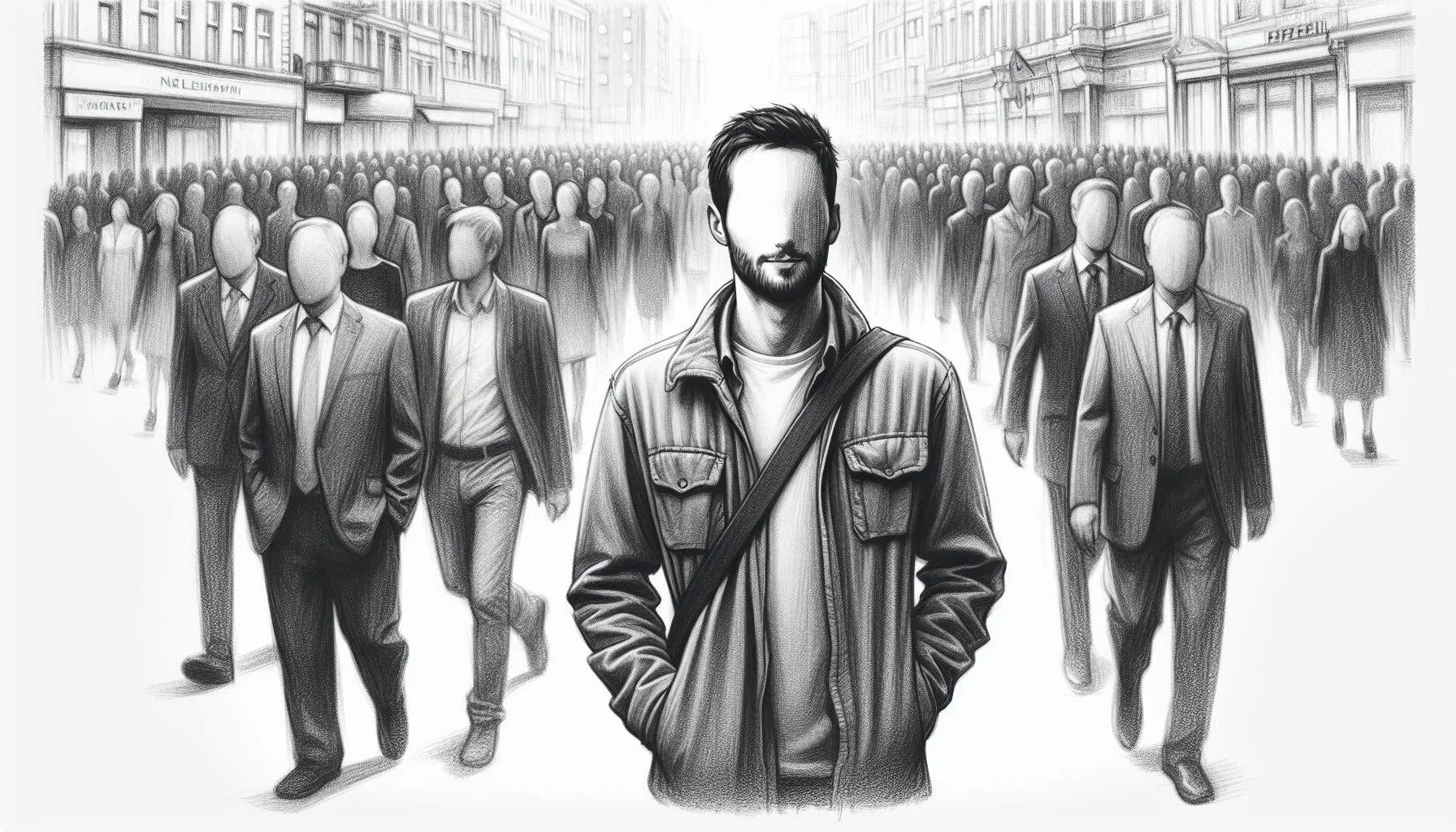Gray Man in the World of Intelligence - Do Agents Really Use This Tactic?
Gray Man in Urban Flow
In today's world, where technology enables tracking every step and social media shapes perceptions of identity in seconds, the ability to remain unnoticed becomes not just a skill but a strategic advantage. It is in this context that the concept of the "Gray Man" emerges - a behavioral tactic that allows a person to blend into their surroundings without arousing suspicion or interest. This strategy is based on principles of restraint, adaptability, and control over one's appearance and behavior.
The term "Gray Man" literally translates to "gray person," symbolizing neutrality, invisibility, and the absence of distinctive features that might attract attention. In the realm of personal security, this concept has long been known among civilian survival enthusiasts, but its significance grows considerably when it comes to professional intelligence work. In espionage, counterintelligence, and field operations, the ability to remain "invisible" can be decisive for the success of a mission and the safety of the agent.
This article aims to explore how deeply the "Gray Man" concept is integrated into intelligence practices, whether it is truly used by agents, and what advantages or risks it entails. We will examine its theoretical foundations, practical examples, alternative approaches, and answer frequently asked questions surrounding this topic. The material will be useful both for those interested in security and for those seeking to better understand the mechanisms of modern intelligence operations.
What Is the "Gray Man"?
Behavioral Contrast — Neutral vs Expressive
The "Gray Man" concept is not merely a set of behavioral rules but a comprehensive strategy that enables a person to remain unnoticed in any social environment. Its essence lies in not standing out, not attracting attention, and not creating an impression that could spark interest or suspicion. Literally translated from English, "Gray Man" means "gray person," symbolizing neutrality, the absence of bright features, and the ability to blend into the background.
Historically, this concept originated among civilian survivalists who sought to avoid danger during social upheavals or emergencies. It was later adapted for the needs of intelligence services, where the ability to remain unnoticed became critically important for successful task execution. In espionage and counterintelligence, the "Gray Man" is not just a behavior but a tool that allows an agent to operate without exposure, gather information, and avoid conflict.
Key principles of this strategy include:
Restraint in appearance: clothing should be neutral, without logos, bright colors, or accessories.
Control over emotions and body language: gestures, facial expressions, and posture should be calm and natural.
Adaptability: the ability to quickly change behavior according to the situation without arousing suspicion.
Minimization of social interaction: avoiding conversations that might attract attention or create a memorable image.
Thus, the "Gray Man" is not just a way to stay in the shadows but a complex system of self-control that requires a high level of self-awareness, discipline, and understanding of social dynamics.
Theoretical Application in Intelligence Services
Within the structure of modern intelligence services, the "Gray Man" tactic holds a special place as an operational tool that enables agents to act in high-risk environments without attracting attention. The theoretical justification for this concept is based on principles of perception psychology, social adaptation, and behavioral neutrality. In training programs for operatives, it is considered not as a standalone technique but as part of a broader system of disguise, surveillance, and evasion.
Intelligence agencies in various countries incorporate elements of the "Gray Man" into agent training, especially for those operating in urban environments where population density, video surveillance, and social dynamics create challenging conditions for covert activity. In such settings, bright clothing, excessive emotionality, or unusual behavior can instantly draw attention, jeopardizing the mission or even the agent's life.
The theoretical application of the "Gray Man" includes:
Modeling appearance: selecting clothing, hairstyle, and accessories that do not stand out among the general population in a specific region.
Behavioral programming: training agents in restraint, conflict avoidance, and control over emotions and reactions.
Social integration: the ability to blend into the environment without arousing suspicion, even while performing tasks that require observation or information gathering.
Psychological resilience: developing self-control skills to endure prolonged periods in the "gray person" role without losing effectiveness.
This tactic is especially relevant for agents working undercover, conducting surveillance, or carrying out missions in conditions where any exposure could have catastrophic consequences. It helps reduce the risk of detection, enhances information gathering efficiency, and ensures the safety of both the agent and the entire operation.
Practical Examples
Quiet Observation from Café
The practical application of the "Gray Man" concept in intelligence services is confirmed by numerous operations where invisibility was a key factor in success. One of the most common scenarios involves undercover agents operating in hostile environments - for example, in countries with high levels of control or within criminal organizations.
In such conditions, an agent must not only blend into the surroundings but also adapt to local norms of behavior, language, dress style, and social habits. For instance, in some operations, agents used the "Gray Man" tactic to infiltrate terrorist groups, where any deviation from expected behavior could lead to exposure.
Another example is the work of operatives in megacities, where population density and the presence of surveillance cameras create a complex environment for information gathering. Here, the "Gray Man" tactic allows an agent to remain invisible in a crowd, avoiding suspicion even during prolonged observation.
Successful application of this strategy often depends on small details: how to hold one's hands, where to look, how to react to unexpected situations. These nuances determine whether the agent is perceived as part of the environment or draws attention.
Thus, practical examples demonstrate that the "Gray Man" is not just a theory but a real tool that enables agents to operate effectively in the most challenging conditions.
Advantages and Disadvantages
The "Gray Man" tactic offers a number of advantages that make it attractive for use in intelligence and security. At the same time, it is not a universal solution and has limitations that must be considered when planning operations or preparing agents.
Advantages:
Reduced risk of exposure
The primary goal of the "Gray Man" is to avoid attention. In situations where any exposure could have fatal consequences, the ability to remain unnoticed is critically important. An agent who does not stand out has a better chance of completing the mission without interference.Flexibility in urban environments
In large cities, where thousands of people pass by daily, the "Gray Man" strategy allows an agent to blend into the crowd without arousing suspicion. This is especially useful for surveillance, movement, or information gathering.Psychological advantage
Invisibility creates a sense of control over the situation. An agent who knows they are not being noticed can act more confidently, without being distracted by external threats.Universality
The principles of the "Gray Man" can be adapted to various cultural, social, and geographic contexts. This makes the tactic useful for agents operating in international environments.
Disadvantages:
Psychological pressure
Constant self-control, suppression of emotional expressiveness, and avoidance of social interaction can lead to internal tension. The agent must suppress natural reactions, which can affect mental health.Communication limitations
The "Gray Man" tactic involves minimal interaction with others. In some situations, this can complicate tasks that require establishing contacts or gathering information through conversation.Risk of arousing suspicion due to excessive restraint
In certain social contexts, overly neutral behavior may appear odd. A person who stands out by not standing out may attract attention precisely because of their "gray" presence.Not always effective in active interaction scenarios
In situations where the agent needs to influence others, negotiate, or demonstrate leadership, the "Gray Man" strategy may be ineffective. Other approaches are needed that allow the agent to assert themselves.
Thus, while the "Gray Man" is a powerful tool in the security field, its application requires a deep understanding of context, psychological preparation, and the ability to adapt to changing conditions. It is not a universal formula but a flexible strategy that should be part of a broader arsenal of agent skills.
Alternative Approaches
Although the "Gray Man" tactic has its advantages, it is not the only strategy used by intelligence services to ensure effective agent performance. There are several alternative approaches that may be more appropriate depending on the operation's context, the agent's personality, and the mission's objectives.
Alpha Presence
This approach is based on demonstrating confidence, strength, and control over the situation. An agent using "Alpha Presence" deliberately attracts attention, creates the impression of an authoritative figure, and uses psychological pressure to achieve results. This strategy can be effective in situations where dominance, negotiation, or influence over others is required.
Undercover Blend
This tactic involves deep immersion into the role the agent is playing. It requires not only external adaptation but also internal acceptance of the behavior, language, habits, and even emotions of the target environment. "Undercover Blend" allows the agent to become part of the target group, significantly reducing the risk of exposure.
Social Engineering
This strategy is based on manipulating social connections, emotions, and people's behavior to obtain information or access resources. An agent using social engineering may impersonate another person, create false scenarios, or employ psychological techniques to achieve their goal.
Tactical Visibility
In some cases, an agent deliberately demonstrates their presence to create a diversion or alter the dynamics of a situation. This approach can be useful for disinformation, creating chaos, or diverting attention from the main operation.
Each of these strategies has its own advantages and risks. The choice of tactic depends on many factors: the type of mission, threat level, cultural context, and the agent's personal qualities. Successful intelligence work often involves a flexible combination of different approaches, allowing adaptation to changing conditions and achieving objectives with maximum efficiency.
FAQ
This section compiles answers to the most frequently asked questions related to the "Gray Man" concept and its application in the world of intelligence. They help to better understand the essence of the concept, its practical significance, and its limitations.
What does the term "Gray Man" mean?
"Gray Man" is a behavioral strategy that enables a person to remain unnoticed in a social environment. It is based on principles of neutrality, restraint, and adaptability, allowing one to avoid attention and blend into surroundings.
Do intelligence services really use this tactic?
Yes, elements of the "Gray Man" tactic are integrated into the training programs of many intelligence services. It is especially relevant for agents working undercover or conducting surveillance in high-risk conditions.
Can the principles of "Gray Man" be applied in everyday life?
Yes, particularly in the context of personal safety. For example, in situations of civil unrest or unfamiliar environments, the ability to remain unnoticed can reduce the risk of conflict or danger.
What skills are needed to effectively use this tactic?
Key skills include self-control, understanding of social dynamics, adaptability to surroundings, and psychological resilience. It is also important to be able to model appearance and behavior according to context.
Are there risks associated with using the "Gray Man" tactic?
Yes, excessive restraint can arouse suspicion, especially in environments where active social interaction is expected. Additionally, prolonged self-control can lead to psychological exhaustion.
How does "Gray Man" compare to other intelligence tactics?
It is one of many strategies used depending on the situation. In some cases, more effective approaches may involve active interaction or demonstration of authority, such as "Alpha Presence" or "Undercover Blend."
Conclusion
The "Gray Man" concept is one of the most intriguing and complex strategies used in the field of security and intelligence. Its strength lies not in active actions but in the ability to remain on the sidelines, to be part of the background without eliciting any emotions or reactions. In a world where information is currency and attention is risk, such a tactic gains special significance.
As shown in this article, the "Gray Man" is not just a set of rules but a deeply integrated behavioral system that requires a high level of self-control, adaptability, and understanding of social context. It has a clear theoretical foundation, is supported by practical examples, and is considered an effective tool in the training of intelligence agents.
However, like any strategy, it has its limits. Excessive restraint can arouse suspicion, and prolonged emotional neutrality can lead to psychological exhaustion. Therefore, the "Gray Man" should not be viewed as a universal solution but rather as one of many tactics to be applied depending on the situation.
In summary, the "Gray Man" tactic is the art of being present without leaving a trace. And although it may not always be visible to the outside eye, its impact on mission success, agent safety, and intelligence effectiveness is undeniable. In the world of intelligence, where every move matters, the ability to be a "gray person" is not a weakness but a strategic advantage.
Looking for more? Check out our other pieces on gray man, bugout, and prepper skills
The Psychology of the Gray Man: How to Disappear in a Crowd
How to Disappear Without a Trace: Safety Techniques
Communication Without a Trace: How to Avoid Compromise
Stealthy Movement Routes - How to Plan Paths for Avoiding Danger
How to Stay Safe While Working in Your Browser
The Digital Shadow in a World of Surveillance. Honest review of NordVPN
Honest Review of Surfshark VPN: How It Can Assist in Grayman, Prepper, and Bugout Approaches










